
Edward Winter
From page 119 of CHESS, October 1983, in a feature by Ian Mullen:

The present article will show that there are numerous impurities concerning this famous game.
Below is the text of C.N. 1394, written in 1987 and also given on pages 17-18 of Chess Explorations:
Alekhine’s second volume of best games contains a brilliancy v ‘S. Freeman’ played at a ‘Blindfold Record Exhibition on 26 Boards. New York, May, 1924’.
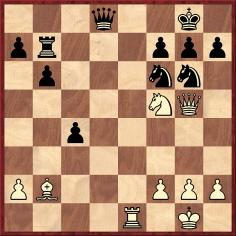
Alekhine gives the finish as 22 Bxf6 Qxf6 (‘Or 22...gxf6 23 Qh6 Qf8 24 Re8, followed by mate.’) and ‘White announces mate in four moves: 23 Re8+ Nf8 24 Nh6+ Qxh6 25 Rxf8+ Kxf8 26 Qd8 mate.’ This spectacular finish continues to be widely published, unjustifiably.
The display was reported on pages 126-129 of the May-June 1924 issue of the American Chess Bulletin. Page 129 gives the score of the game in question: 22 Bxf6 gxf6 ‘White mates in three moves’. There follows a note to Black’s 22nd move: ‘Alekhine announced that if 22...Qxf6, then mate in four, as follows: 23 Re8+ Nf8 24 Nh6+ Qxh6 25 Rxf8+ Kxf8 26 Qd8 mate.’
The American magazine gives Black’s name as A. Frieman. Also, the exhibition did not take place in May, but from 14.00 on 27 April to 02.00 on 28 April.
Although the ‘brilliancy’ continues to be republished, the above refutation [of Alekhine’s version of events] was reported long ago. As far as we know, the first to note it was Paul Leith; see the BCM, November 1960 (page 328) and February 1961 (pages 58-59).
The American Chess Bulletin reports that Alekhine ‘brought off the prettiest finish of the day against S. Hecht of the Stuyvesant Chess Club. This victory, which startled the onlookers, involved the sacrifice of both of Alekhine’s rooks. The acceptance of this Grecian gift by Hecht led to a forced mate in four moves, which Alekhine announced to the accompaniment of loud applause.’
That sounds like the game that deserves to be remembered, but the score is not given. Does anyone have it?
(Nothing further has been discovered about the Hecht game.)
From My Best Games of Chess 1924-1937 by A. Alekhine (London, 1939), pages 250-251:

The game details had been presented similarly by Alekhine on pages 33-34 of Auf dem Wege zur Weltmeisterschaft (Berlin and Leipzig, 1932).
The first known publication of the game is by Hermann Helms in the Brooklyn Daily Eagle, 1 May 1924, page 4A:

After Alekhine’s games against Pinkus, Berman and Monsky, Helms gave:
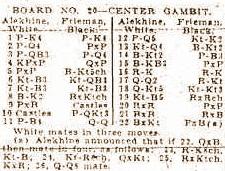
There was extensive coverage of the display on pages 126-129 of
the May-June 1924 American Chess Bulletin. The first two
pages:
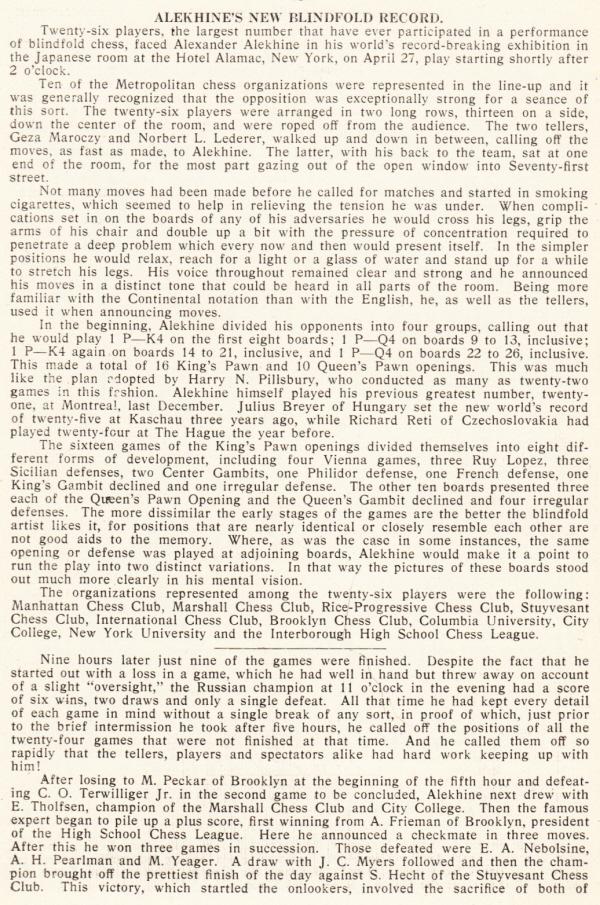

Five games were published (the additional one being Alekhine’s victory over Steiner). The Frieman game was on page 129 (with an incorrect board number in the heading, but otherwise the text was identical to what had been printed in the Brooklyn Daily Eagle):

Given that the 23 Re8+ brilliancy was merely a variation, it is understandable that the game was not published extensively at the time. As will be seen in the next section, page 336 of the August 1924 BCM gave the score and other details as reported in the American Chess Bulletin (Black duly named as Frieman and with the conclusion ‘22 BxKt PxB. White announced mate in three moves’). The same information appeared on pages 96-97 of volume one of Schachjahrbuch 1924 by L. Bachmann (Ansbach, 1925), except that there were two spellings of Black’s name (Friemann and Frieman).
From page 328 of the November 1960 BCM:

A follow-up item was published on pages 58-59 of the February 1961 BCM:

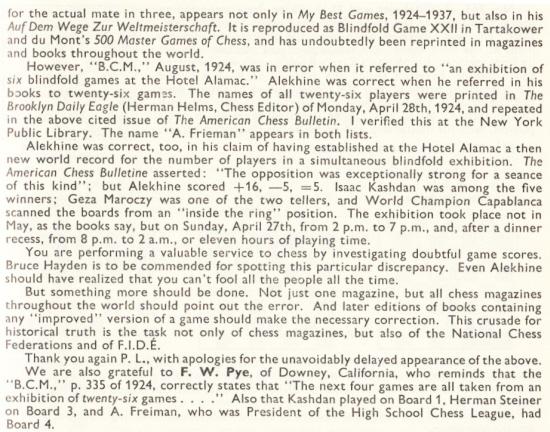
It is worth highlighting D.J. Morgan’s concluding comments:
‘But something more should be done. Not just one magazine, but all chess magazines throughout the world should point out the error. And later editions of books containing any “improved” version of a game should make the necessary correction. This crusade for historical truth is the task not only of chess magazines but also of the National Chess Federations and of FIDE.’
Of course, the game continued to appear regularly in what, for brevity’s sake, will be referred to as the ‘Freeman/Qxf6’ version (as opposed to ‘Frieman/gxf6’).
Below is the fine coverage on pages 229-230 of Alexander Alekhine’s Chess Games, 1902-1946 by L. Skinner and R. Verhoeven (Jefferson, 1998), reproduced with the co-authors’ permission:
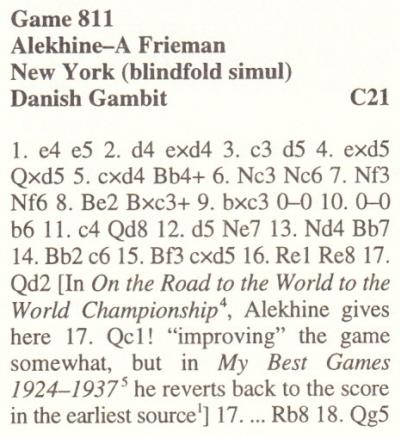
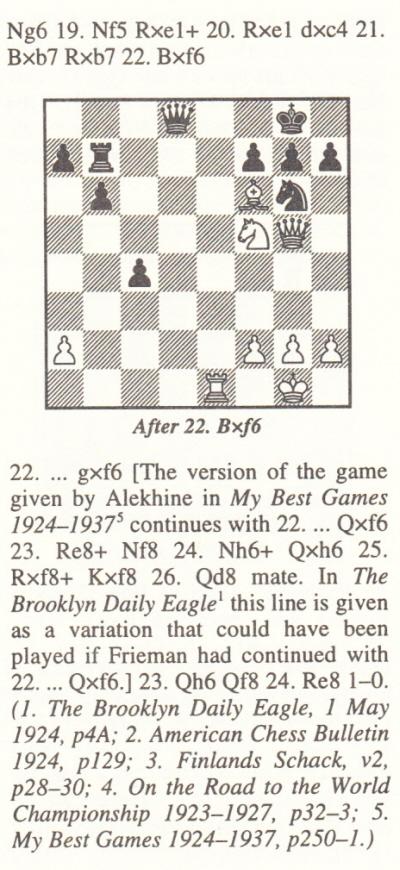
See too the general report on the display, on pages 228-229.
In a sense, publication of the game since the time of D.J. Morgan’s articles has been predictable, for it can usually be anticipated which writers will be in which camp, i.e. ‘Freeman/Qxf6’ or ‘Frieman/gxf6’. Unsurprisingly, page 319 of The Games of Alexander Alekhine by R. Caparrós and P.P. Lahde (Brentwood, 1992) and page 115 of Alexander Alekhine Master of Attack by A. Raetsky and M. Chetverik (London, 2004) had ‘Freeman/Qxf6’. So did page 183 of Ajedrez a la ciega by B. López Esnaola (Madrid, 1989), whereas pages 257-258 of Blindfold Chess by E. Hearst and J. Knott (Jefferson, 2009) presented the details accurately. The game was also given with precision on page 17 of Alekhine in the Americas by J. Donaldson, N. Minev and Y. Seirawan (Seattle, 1992). Page 50 of Alekhine 222 partidas (Madrid, 1990) had a hybrid version: ‘S. Frieman/Qxf6’.
Yet it should not be a difficult matter to get right. The need to avoid ‘Freeman/Qxf6’ could even be learned from items by A. Soltis on pages 6-7 of The Book of Chess Lists (Jefferson, 1984) and on page 99 of Chess Lists (Jefferson, 2002), although as in other cases (see, for instance, C.N. 5217) he gave no credit to D.J. Morgan or anyone else.
New editions of Alekhine’s books have not bothered to correct the record, examples being On the Road to the World Championship 1923-1927 (Oxford, 1984) and My Best Games of Chess 1908-1937 (Milford, 2013).
Special mention may be made of Spanish translations of Alekhine’s second volume of best games (Mis mejores partidas de ajedrez 1924-1937). We have three editions, all of which give the faulty game conclusion. Strangely, though, none of them follows Alekhine’s spelling ‘Freeman’, although all are still wrong:
Buenos Aires, 1940 (pages 248-249): S. Frieman;
Buenos Aires, 1962 (pages 258-259): S. Friedmann;
Madrid, undated, circa 2010 (page 236): S. Friedmann.
Moreover, the second of these books inexplicably transferred the game to Paris the following February (‘Exhibición a ciegas sobre 26 tableros (record), París, febrero de 1925’).
As noted in C.N. 845, on page 70 of An Introduction to Chess by S. Taulbut (Ramsbury, 1984) the Freeman/Qxf6 version was given with a date which was a decade astray: ‘New York, 1934’.
When the chess world’s most disreputable writers publish such a game, the sight is unlikely to be pretty.
On pages 21 and 189 of The Big Book of Combinations (San Francisco, 1994) Eric Schiller gave the Freeman/Qxf6 version. For the venue he was unable to be more precise than ‘United States’. That is natural enough because, as shown in our Copying article, his book plagiarized the Encyclopaedia of Chess Middlegames (Belgrade, 1980) and ‘USA’ is what appeared there (page 202).
World Champion Combinations by R. Keene and E. Schiller (New York, 1998), page 238:
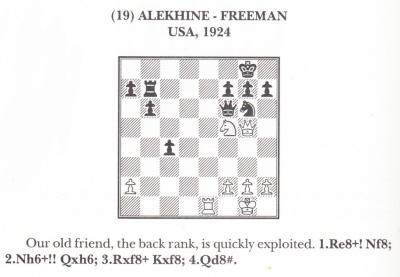
Our 1998 feature article on the book commented:
‘The next diagram is for ‘Alekhine-Freeman, USA, 1924’. Firstly, Black was Frieman. Secondly, USA should read New York. Thirdly, the game continuation given is wrong, being a well-known case of Alekhine’s subsequent invention of a more spectacular win. (See, for instance, C.N. 1394 and page 17 of Chess Explorations.)’
In 2003 the same publisher, Cardoza, brought out Killer Chess Tactics by R. Keene, E. Schiller and L. Shamkovich. As noted in C.N. 7884, page 11 stated that the ‘second half of the book is a revised and updated version of World Champion Combinations, by Raymond Keene and Eric Schiller’. So, would they revise and update (i.e. correct) the mistakes made in the earlier book’s coverage of Alekhine v Frieman?
The answer is that an attempt was made and that it was a fiasco. The desire to revise and update Freeman to Frieman merely resulted in a fresh misspelling, Freiman. From page 260:
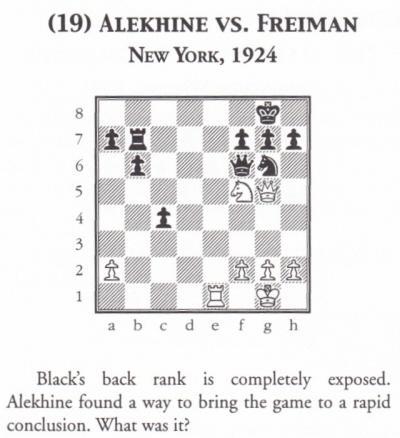
When the ‘solution’ was given on page 394 the misspelling Freiman was repeated and a final sentence was added concerning the authenticity of the finish. It was gibberish:

Page 35 of The Times Winning Moves by R. Keene and B. Jacobs (London, 2003) reverted to the straightforwardly wrong Freeman/Qxf6 version:
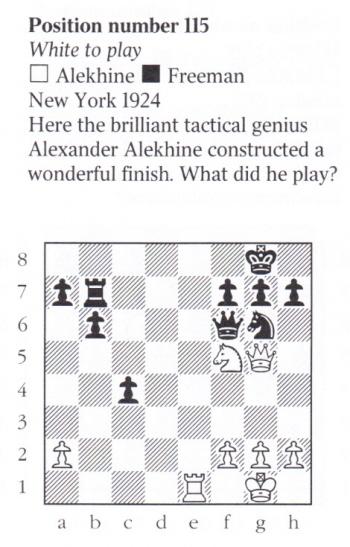
On page 64 of The Sunday Times Book of Chess (Aylesbeare, 2005), in a column dated 13 May 2001, Raymond Keene stuck with Freeman/Qxf6 but branched out with a new date for the game:
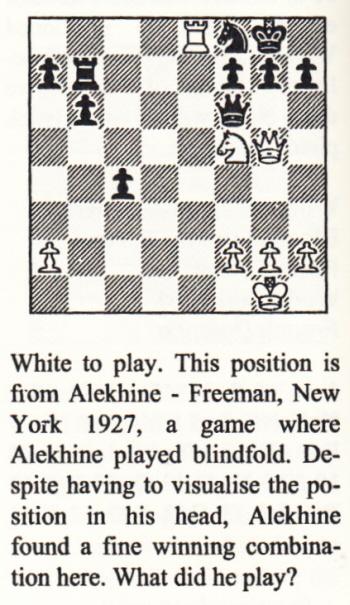
Position 31 in Little book of Chess Secrets by Raymond Keene (Glasgow, 2013):
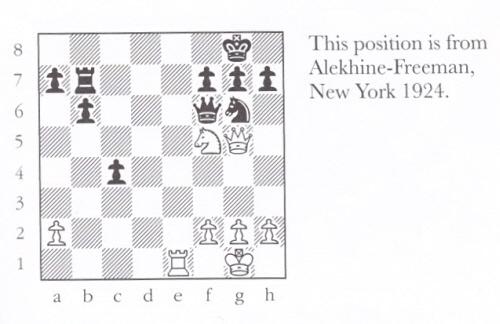
(8396)
C.N. 12048 referred to Raymond Keene, OBE, Ctrl+C, Ctrl+V.
To the Chess Notes main page.
To the Archives for other feature articles.
Copyright: Edward Winter. All rights reserved.